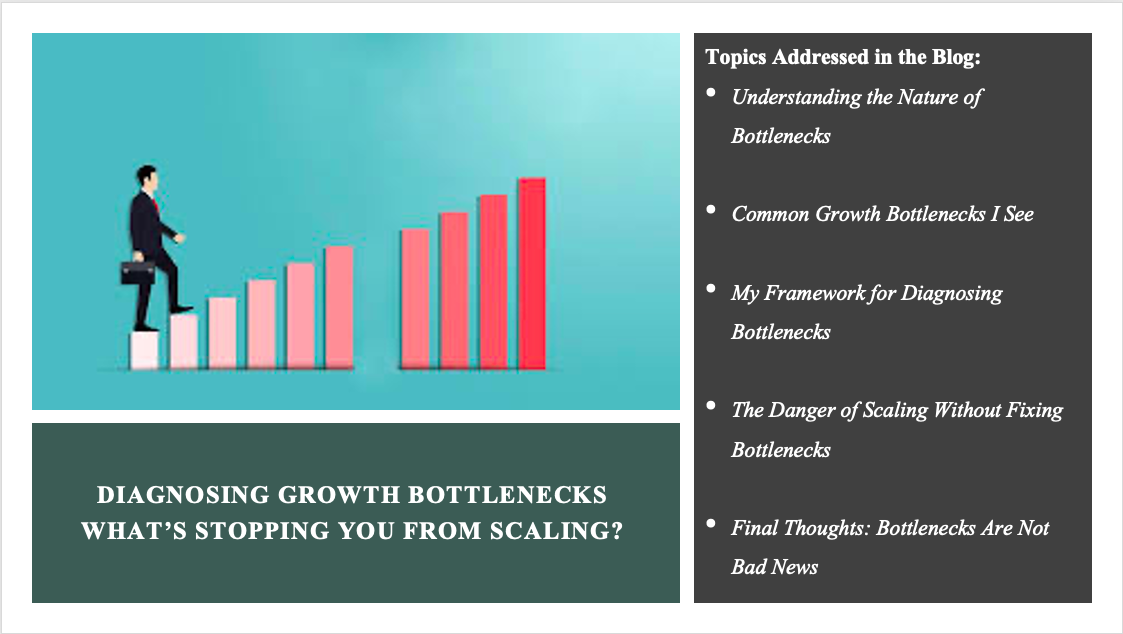Every founder reaches a point when growth slows, stagnates, or worse — reverses. And in most cases, it’s not because the idea isn’t good or the market isn’t ready. It’s because something within the business — the structure, the mindset, the execution — is bottlenecking its potential to scale.
Diagnosing these growth bottlenecks is one of the most critical yet most ignored stages in a business journey. Founders often chase new strategies, funding, or product tweaks, while the real issue lies hidden in plain sight.
This blog walks you through how I, as a business growth mentor, approach this diagnosis — and how you can too.
1. Understanding the Nature of Bottlenecks
A bottleneck is any point in your business that slows down progress despite the rest of the system being ready to grow. It can be operational, strategic, emotional, or even cultural. What makes it tricky is that it often hides under surface-level symptoms — missed revenue targets, high churn, repeated firefighting, team disengagement, or lack of scalability.
The key is not to fix the symptom but to go deeper.
2. Common Growth Bottlenecks I See
– Lack of Strategic Focus: Too many directions, no clear roadmap.
– Founder Dependence: Everything revolves around the founder; decisions, execution, motivation.
– Weak Middle Management: No empowered second line of leadership.
– Broken Internal Processes: SOPs are missing, outdated, or not followed.
– Poor Data Visibility: Decisions based on assumptions, not data.
– Customer Experience Gaps: Sales is happening, but retention and advocacy are low.
– Team Misalignment: People rowing, but not in the same direction.
– Underinvestment in Marketing: Product is ready, but no one knows about it.
– Cultural Drift: Core values diluted as the company grows.
The symptoms might vary, but the root often lies in one of these areas.
3. My Framework for Diagnosing Bottlenecks
When I work with a founder or leadership team, I follow a simple but powerful 5-step framework to diagnose bottlenecks:
1. Listen Deeply – Understand the founder’s vision, frustrations, and current narrative.
2. Map the System – Lay out every moving part of the business: People, Process, Product, Profit.
3. Identify Friction Points – Where do tasks get stuck? Where do decisions get delayed? Where do clients drop off?
4. Measure the Intangibles – Culture, energy, alignment, ownership. These don’t show up in dashboards, but they decide the future.
5. Prioritize Intervention Zones – Not everything can be fixed at once. We choose where to focus for maximum compounding impact.
This framework turns confusion into clarity. And once we see clearly, we can act strategically.
4. The Danger of Scaling Without Fixing Bottlenecks
Scaling a business without addressing internal bottlenecks is like building floors on a shaky foundation. You might attract customers, investors, and even short-term revenues — but eventually, cracks show. Delivery falters, morale drops, and leaders burn out.
True scale is not just about growing bigger. It’s about growing better — with systems, structure, and soul.
5. Final Thoughts: Bottlenecks Are Not Bad News
Here’s the truth: Bottlenecks are not signs of failure. They’re signs of movement. Only growing companies encounter them. The key is to spot them early, address them courageously, and build beyond them consciously.
As a mentor, I don’t just look at your business. I look into it — with you. We clear the path so your business can move with intention and momentum.
So if you’re feeling stuck, maybe it’s not your idea or your team. Maybe it’s just time for a diagnosis.
Let’s unclog the flow. Let’s scale — the right way.


Leave a Reply to Manjunath Bhat Cancel reply